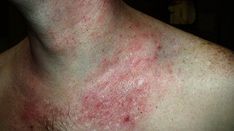Background
Gianotti-Crosti syndrome is a self-limited childhood exanthem that manifests in a characteristic acral distribution. It is rarely associated with systemic findings. The original cases, described in Italy by Gianotti in 1955, were associated with hepatitis B virus infection, although other viral infections currently account for most cases.
The two older, descriptive designations, papular acrodermatitis of childhood (PAC) and papulovesicular acrolocated syndrome (PAS), described indistinguishable clinical entities. PAC is the term most commonly used today.
Also see the Medscape Drugs & Diseases article Gianotti-Crosti Syndrome.
Pathophysiology
Although the original reports of Gianotti-Crosti syndrome (papular acrodermatitis of childhood) were attributed to acute infection with the hepatitis B virus, more recent studies have demonstrated that Gianotti-Crosti syndrome is more commonly associated with a number of other infectious agents, both viral and bacterial. In the United States, the agent that has been reported most frequently in association with Gianotti-Crosti syndrome is Epstein-Barr virus (EBV).
The pathophysiologic process underlying Gianotti-Crosti syndrome remains unknown, although it is believed to represent an immunologic response to transient viremia or bacteremia, possibly a delayed-type hypersensitivity response. Deposition of circulating immune complexes in the dermis may play a role. Several studies have failed to demonstrate deposition of viral particles or bacteria within the dermis.
Etiology of Gianotti-Crosti Syndrome
Gianotti-Crosti syndrome has been associated with the following infectious agents:
-
Hepatitis B virus, most commonly ayw strain [1]
-
Coxsackieviruses, [8, 9, 4] echoviruses, and other enteroviruses [7]
-
Cytomegalovirus [8, 1, 11]
-
Influenza virus, type A [12]
-
Human herpesvirus 6, both primary infection and reactivation of latent infection [13]
-
Herpes simplex virus-1 [14]
-
Rotavirus [15]
-
Hepatitis C virus [11]
-
Human immunodeficiency virus [11]
-
Group A beta-hemolytic streptococci
-
Neisseria meningitidis [16]
-
Mycoplasma pneumoniae [17]
-
Bartonella henselae
-
Borrelia burgdorferi
Gianotti-Crosti syndrome has also been reported to occur after vaccination for the following:
Epidemiology
Frequency
United States
Gianotti-Crosti syndrome (papular acrodermatitis of childhood) occurs sporadically in the clinical setting, with no apparent genetic or familial predisposition. Gianotti-Crosti syndrome appears to be uncommon and may go unrecognized because of its generally benign and self-limited course. Gianotti-Crosti syndrome is more commonly seen in the spring and summer, possibly as a result of a concomitant increase in viral illness seen in the general population.
International
The distribution of Gianotti-Crosti syndrome (papular acrodermatitis of childhood) is worldwide, with cases reported in Great Britain, France, Germany, Spain, Russia, Turkey, India, Hong Kong, China, and Japan. In one series of 20,000 patients younger than 5 years seen over a 5-year period in Bordeaux, France, 26 patients with features consistent with Gianotti-Crosti syndrome were identified, yielding an annual incidence of 0.13%. [8]
Race
No racial predilection is apparent for Gianotti-Crosti syndrome.
Sex
In children, males and females are equally affected. Reported cases in adults have been seen almost exclusively in females.
Age
The onset of the eruption typically occurs in children aged 3 months to 15 years, with an average age of 2 years and a peak incidence at 1-6 years. Adult cases are rare but have been reported in women aged 17-46 years. [17, 32, 33, 34, 24, 35, 36]
Prognosis
The prognosis is excellent. This syndrome is generally a benign, self-limited condition. The eruption usually starts to resolve after 6-8 weeks.
In the original cases of hepatitis B virus-associated disease, anicteric hepatitis developed in a proportion of patients. Anicteric hepatitis may also be seen in cases associated with other viral illnesses such as EBV.
In extremely rare cases, chronic liver disease has followed the initial phase of infection with hepatitis B virus.
Patient Education
Discussion with the parents regarding the benign, self-limited course is advisable. If a particular viral or bacterial infection is suspected as the etiology, the course of the associated infection should also be discussed.
-
Characteristic erythematous papules of Gianotti-Crosti syndrome appear on the face of this child. The child does not have a toxic appearance.
-
Characteristic erythematous papules of Gianotti-Crosti syndrome can be seen on the extremities, as is the case in this young child.
-
A 9-year-old girl who recently returned from a trip to Europe with her family. She developed a low-grade fever, malaise, and some lymphadenopathy. An eruption limited to her face, arms, legs, and buttocks was noted.
-
A mildly pruritic eruption characterized by erythematous papules localized to the face, arms, legs, and buttocks.










